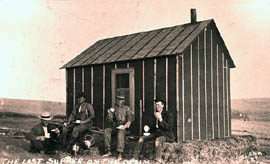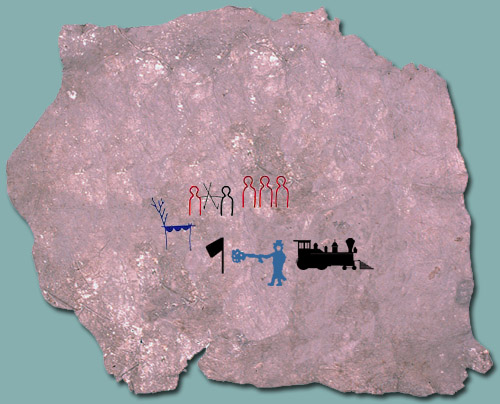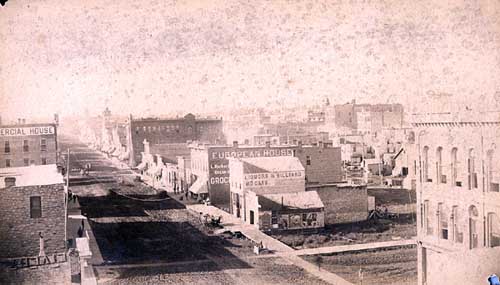|
Lesson 2
Town Life and Hard Times
|
| |
|
Timeline |
|
| 1862 |
| Homestead
Act passes |
| 1873 |
| First
railroads reach Dakota |
| 1876 |
| Gold
rush begins |
| 1878 |
| Great
Dakota Boom begins |
| 1886 |
| Railroad
reaches Black Hills |
| 1886-1887 |
| Hard
winter kills many cattle |
| 1889 |
| South
Dakota becomes a state |
| 1904 |
| New
land openings begin |
| 1907 |
| Railroad
bridges cross Missouri River |
| 1913 |
| State
issues first license plates |
| 1917 |
| United
States enters First World War |
| 1924 |
| All
American Indians become United States citizens |
|
In the beginning, most of the railroad towns
looked pretty much alike. Streets ran east and west, north and south.
The train depot perched at one end of Main Street. The railroad tracks
often formed a "T" with Main Street. At the other end was
nothing but open prairie. Buildings lined streets of bare earth or mud.
Some had false fronts that made them look two stories high. Schoolhouses
were often one of the most important buildings in town. They became
centers of the community, a place where people got together for fun or
public business.

Photo courtesy of South Dakota State
Historical Society
Newspapers were an important business on
Main Street. Small towns had newspapers that were printed once a week.
Larger towns had newspapers printed every day. The newspapers let
everyone know who had claimed what land and where it was. Some were
printed in different languages because immigrants could not speak
English. They brought news from the outside world. They tried to bring
more settlers to Dakota. They knew that the wealth of the town depended
on the number of farms around it.
|
|
Most families who came to Dakota farmed
on their 160-acre claims. They had to build a house there to prove
that they were living on the land. Some people bought lumber in town
and put up claim shanties. These tiny houses were drafty and cold.
The floors were dirt. Because wood was scarce, many homesteaders
built
sod houses. These soddies were made of blocks of prairie
sod.
Some were leaky and dangerous. The roofs could
collapse under rain
or heavy snow.
|

Photo courtesy of South Dakota State
Historical Society
|
|

Photo courtesy of South Dakota State
Historical Society

Winter Count
|
Snow was something Dakotans soon
knew a lot about. The Hard Winter of 1880-1881 took many by surprise.
Temperatures
hovered below zero for weeks. Snow fell so deep that
trains could not get through. For most families, that meant no food,
fuel, or supplies. There was no
kerosene for lamps to light long
winter nights. "The dark came in, loud with the roar and the
shrieking of the storm," wrote Laura Ingalls Wilder in The Long
Winter. There was no flour for bread. There was no coal to
heat the freezing air inside their houses. Families burned twisted
sticks of hay instead. They ground wheat seed for flour. When the
spring thaw finally came, the Missouri, Big Sioux, and James rivers
flooded their banks. The Missouri River swept the whole town of
Vermillion away. The flood broke up so many steamboats that
steamboat travel on the Missouri River soon ended.
|
|
Farming during the 1880s was also harder
than it is today. Many new farms had been started on sod that had
never been plowed. Breaking up sod took days of labor. A horse or
mule to draw the plow helped, but many farmers used hand plows. Even
so, wheat crops were good at first. Then prairie fires and drought
hurt harvests; prices for corn and wheat crops fell. Some
homesteaders packed up and moved back east. By 1890, the Great
Dakota Boom was over.
|

Farm Graph

Wheat Graph
|
|

Sioux Falls
|
Yet many Dakota towns grew and did well.
Sioux Falls became a
thriving center for business and industry. The
local rock made good stone for buildings. It was called quartzite.
Cutting, or quarrying, this rock added jobs to the Sioux Falls area.
The rock itself added beauty to the towns all around. Up north,
Aberdeen was the
hub city for many railroads. Farms around the city
did well. The railroads took the crops to eastern markets. They
brought back food, lumber, tools, and supplies. Aberdeen businessmen
began to resell these goods to other stores. They took them out to
small towns in wagons. Aberdeen became an important wholesale
center.
|
|
|
|
| Vocabulary |
|
| collapse (v.), to fall down suddenly
hovered (v.), lingered; hung about
hub (n.), a center
|
kerosene (n.), an oil used in lamps
sod (n.), a piece of ground covered with growing
grass and its roots
thriving (adj.), successful
|
|
|